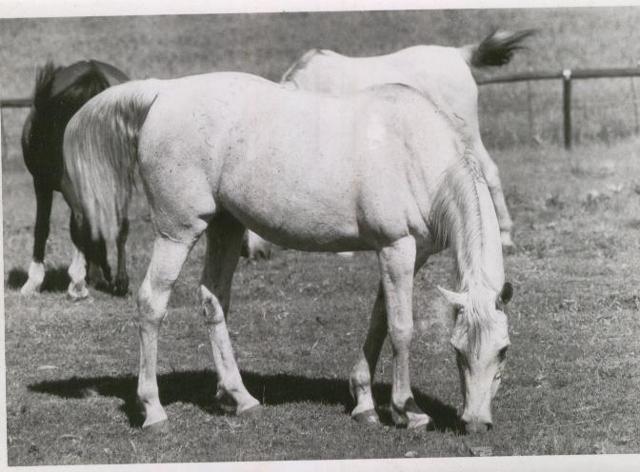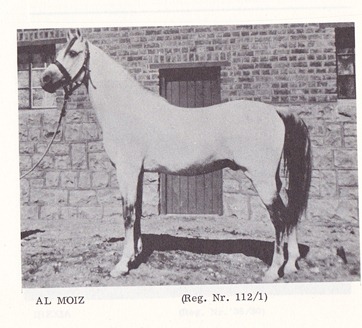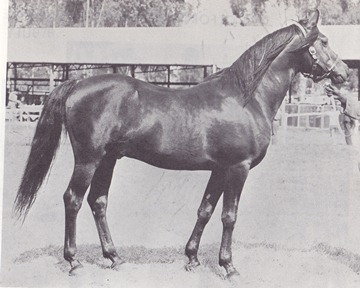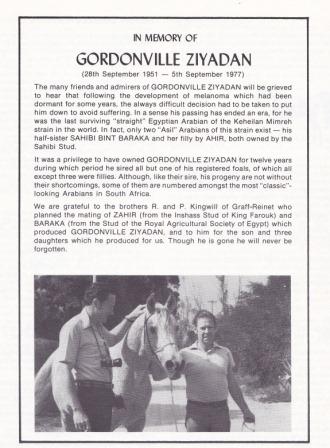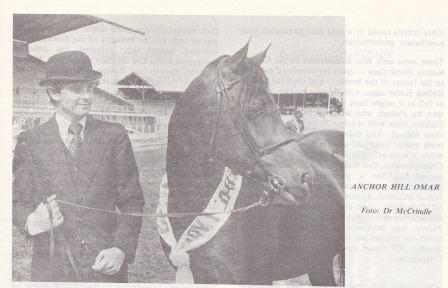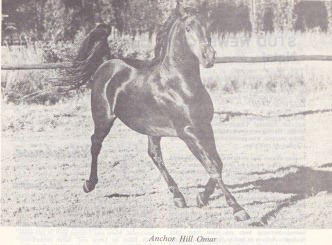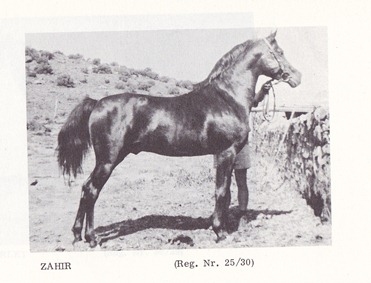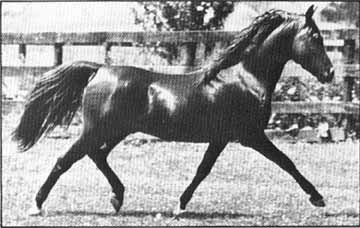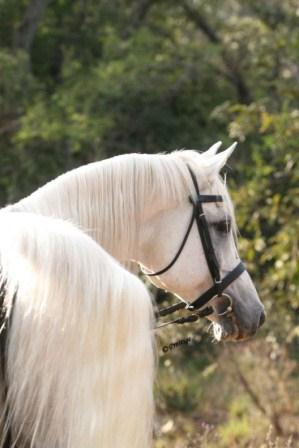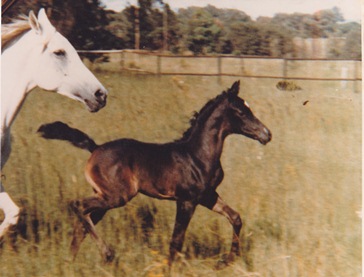Nabilah Egyptian Arabian Bloodstock
Double click to edit
Breeders of world class Asil and Straight Egyptian horses
The Nabilah stud originated with the import of two mares and three stallions to South Africa from the Egyptian Agricultural Organisation (EAO) Cairo, Egypt, during 1943. It had a precarious beginning and struggled to survive, but due to the grace of God it stood the test of time. The descendants of these noble horses of the desert live on in the mares and stallions that grace our stud. Our horses excel both in the show ring and on the endurance track. The Nabilah horses reflect the original desert type in their general appearance, tail carriage, movement and stamina. Our goal is to conserve the unique desert type of the Nabilah horses.


By Gisela Aschenborn Uijs (Taken from Sons of the desert by Jean Power and Karl de Haan.)
“Towards the middle of the Anglo Boer War, Wilhelmus (Willie) left the Cape colony to support the commandos in the Transvaal fighting for their freedom. At that time he learned to appreciate horses with Arab blood, and it was thus no mere coincidence, that when Sir de Villiers Graaff: Bart (who was a nephew of Willie Uijs) imported Arabs, Willie immediately tried to acquire some, and in fact managed to get a few offspring as well as part breds. These two groups were strictly kept apart; the part breds were crossed with other breeds to produce cavalry horses for the army, and the pure-breds were kept pure (though they did not register them).
The Uijs family of Ermelo was well known horsemen of the day and people came from near and far to have their horses trained by them. With the years the asthma of Willy Uijs became so severe that his doctor advised him to move to Namibia (formerly known as South West Africa), which he did, together with his tree sons. Everyone knew Wilhelmus's sentiment for Arab horses, wo when Mr. Claude Orpen prepared to go to Cairo on South African Government orders to import Arabian horses, Dr. Kritzinger (a noted medical specialist in Pretoria), asked that horses should be imported for him as well. Dr Kritzinger was the godchild of Willy Uijs and as the latter had paid for his studies, Dr Kritzinger knew of no better way to thank his Godfather than to give him some exceptional Arabian Horses. Dr Kritzinger confided in one of the sons, Mr. FJ Uijs, and he, as a very knowledgeable stockbreeder described exactly what type of mares and stallions they wanted.
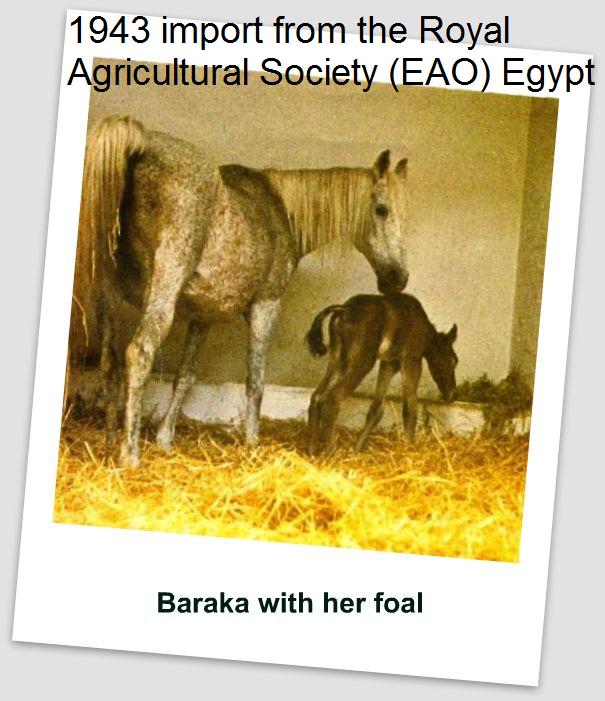
Double click to edit
THE IMPORT
At the Royal Agricultural Society (now known as the EAO) Mr. Orpen selected two mares, Baraka (lbn Manial/Gamalat) and Nabilah (Enzahi/Zanzam) and the stallion ZAD El Rakib by Balance of the Uijs family. He was also invited to visit King Farouk’s stud at Inshass as a friendly gesture to South Africa and the interest of maintaining friendly relations. There he was allowed to choose three additional stallions, El Moez (lbn Fayda/Bint Zareefa) Zahir (lbn Fayda/Zahra) and Nader (Mekdam/Mahasen).
Zahir
These six horses were exported to South Africa under conditions set out in a letter to Mr. Orpen from the South African consul in Cairo who had supervised the proceedings; he wrote: “to say that there were difficulties is to put it very mildly. All told, I must have had over 100 people on the job with one thing or another. There was no firm with equipped or experienced men to undertake the work. Similar jobs had not been done for years. Thomas Cook could get nothing done. Without the assistance of the Engineers both in Cairo and Suez, the boxes would never have been acquired for many months to come. There was no specimen box available and we had to search for specifications in old army manuals and rely on odd advice here and there. Many improvements to the boxes had still to be undertaken later on the quay. Dr Rashid arranged transport from the Royal Agricultural Society for his horses. Scott and Private Morris accompanied the three Inshass horses to Suez in a horse truck for 17 hours. The army supplied transport. Dr Ashoub of the R.A.S. arranged to send his horses to Suez together with three grooms, forage for the journey by sea, medicines and all other equipment. The Ministry of Agriculture gave us the Quarantine station in Suez for stabling the horses and accommodating the four soldier attendants and the three grooms. The veterinary officer there gave us his services for six days and his help was invaluable. The ship was unsuited to horse transport and it would have been impossible to send the horses without special attendants. There were no sleeping quarters and the men volunteered to sleep on the hatch. There were also no messing amenities on the ship so the men had to take their own rations. I can assure you that it is going to be no light task for these men. They are doing it for the love of their charges!!!
The operation of loading the horses at Suez proved even more hazardous: The animals were in fine trim when they left for the military docks at 9:30 am, lead by three of the South African soldier volunteers and the three RAS Syces. On the 10 mile walk to the ship, which took 3 hours, all went well until near the docks, when military traffic scared the spirited Nader who reared, broke his halter, charged Zad El Rakib and bit him. The Syce leading the latter threw his hand in the air and both horses made off. The trusty private Morris managed to catch them amidst the dessert rocks, bleakness and barbed wire. They arrived at the docks about 12:30 pm.
The second stage commenced about 2:00 pm when we started to swing about the box by crane to test it; then we filled it with cheering Arabs piled on top of each other. The box stood the test. Then a start was made on getting the horses into their boxes. Zaher refused to enter his box. No enticement would avail. He also refused to be blindfolded, a struggle set up between him, his handler Sergeant Scott and the vet to no purpose. Zaher drew the honors by biffing Scott behind the ear and so knocking him shaky on his legs. Private Morris tried ultra soothing tactics and the bait of a carrot-still to no avail. Here Major Sawle arrived and took over the carrot but he had no success with it. Finally, after an hour’s struggling, Major Sawle was successful in arranging a catapulting operation from the rear.
Now followed the actual swinging aboard of the crates by crane. The many passing chattering Arab dock workers and busy puffing whistling little dock train had excited the horses in their boxes. There was no trouble in hoisting the mares and El Moez but the real trouble came with hoisting Zaher. He showed great nervousness. When the cables were being attached to the box he strained violently at his head ropes. The ropes did not give but Zahler’s legs came away from under him and he collapsed in the narrow box. From the ship I saw only two equine legs sticking out. What a moment! Morris was in the box and things were dependent on his cool ability and able hands. Zaher not only managed to get up unhurt but Morris also escaped injury. He was advised against going up with Zaher but instead he would do so perched on the front end of the box holding Zaher by the reins. The horse took this quite well so the hoisting operation started and to everyone’s relief was safely accomplished.”
THE IMPORT
At the Royal Agricultural Society (now known as the EAO) Mr. Orpen selected two mares, Baraka (lbn Manial/Gamalat) and Nabilah (Enzahi/Zanzam) and the stallion ZAD El Rakib by Balance of the Uijs family. He was also invited to visit King Farouk’s stud at Inshass as a friendly gesture to South Africa and the interest of maintaining friendly relations. There he was allowed to choose three additional stallions, El Moez (lbn Fayda/Bint Zareefa) Zahir (lbn Fayda/Zahra) and Nader (Mekdam/Mahasen).
Zahir
These six horses were exported to South Africa under conditions set out in a letter to Mr. Orpen from the South African consul in Cairo who had supervised the proceedings; he wrote: “to say that there were difficulties is to put it very mildly. All told, I must have had over 100 people on the job with one thing or another. There was no firm with equipped or experienced men to undertake the work. Similar jobs had not been done for years. Thomas Cook could get nothing done. Without the assistance of the Engineers both in Cairo and Suez, the boxes would never have been acquired for many months to come. There was no specimen box available and we had to search for specifications in old army manuals and rely on odd advice here and there. Many improvements to the boxes had still to be undertaken later on the quay. Dr Rashid arranged transport from the Royal Agricultural Society for his horses. Scott and Private Morris accompanied the three Inshass horses to Suez in a horse truck for 17 hours. The army supplied transport. Dr Ashoub of the R.A.S. arranged to send his horses to Suez together with three grooms, forage for the journey by sea, medicines and all other equipment. The Ministry of Agriculture gave us the Quarantine station in Suez for stabling the horses and accommodating the four soldier attendants and the three grooms. The veterinary officer there gave us his services for six days and his help was invaluable. The ship was unsuited to horse transport and it would have been impossible to send the horses without special attendants. There were no sleeping quarters and the men volunteered to sleep on the hatch. There were also no messing amenities on the ship so the men had to take their own rations. I can assure you that it is going to be no light task for these men. They are doing it for the love of their charges!!!
The operation of loading the horses at Suez proved even more hazardous: The animals were in fine trim when they left for the military docks at 9:30 am, lead by three of the South African soldier volunteers and the three RAS Syces. On the 10 mile walk to the ship, which took 3 hours, all went well until near the docks, when military traffic scared the spirited Nader who reared, broke his halter, charged Zad El Rakib and bit him. The Syce leading the latter threw his hand in the air and both horses made off. The trusty private Morris managed to catch them amidst the dessert rocks, bleakness and barbed wire. They arrived at the docks about 12:30 pm.
The second stage commenced about 2:00 pm when we started to swing about the box by crane to test it; then we filled it with cheering Arabs piled on top of each other. The box stood the test. Then a start was made on getting the horses into their boxes. Zaher refused to enter his box. No enticement would avail. He also refused to be blindfolded, a struggle set up between him, his handler Sergeant Scott and the vet to no purpose. Zaher drew the honors by biffing Scott behind the ear and so knocking him shaky on his legs. Private Morris tried ultra soothing tactics and the bait of a carrot-still to no avail. Here Major Sawle arrived and took over the carrot but he had no success with it. Finally, after an hour’s struggling, Major Sawle was successful in arranging a catapulting operation from the rear.
Now followed the actual swinging aboard of the crates by crane. The many passing chattering Arab dock workers and busy puffing whistling little dock train had excited the horses in their boxes. There was no trouble in hoisting the mares and El Moez but the real trouble came with hoisting Zaher. He showed great nervousness. When the cables were being attached to the box he strained violently at his head ropes. The ropes did not give but Zahler’s legs came away from under him and he collapsed in the narrow box. From the ship I saw only two equine legs sticking out. What a moment! Morris was in the box and things were dependent on his cool ability and able hands. Zaher not only managed to get up unhurt but Morris also escaped injury. He was advised against going up with Zaher but instead he would do so perched on the front end of the box holding Zaher by the reins. The horse took this quite well so the hoisting operation started and to everyone’s relief was safely accomplished.”
Double click to edit
THE IMPORT
At the Royal Agricultural Society (now known as the EAO) Mr. Orpen selected two mares, Baraka (lbn Manial/Gamalat) and Nabilah (Enzahi/Zanzam) and the stallion ZAD El Rakib by Balance of the Uijs family. He was also invited to visit King Farouk’s stud at Inshass as a friendly gesture to South Africa and the interest of maintaining friendly relations. There he was allowed to choose three additional stallions, El Moez (lbn Fayda/Bint Zareefa) Zahir (lbn Fayda/Zahra) and Nader (Mekdam/Mahasen).
These six horses were exported to South Africa under conditions set out in a letter to Mr. Orpen from the South African consul in Cairo who had supervised the proceedings; he wrote: “to say that there were difficulties is to put it very mildly. All told, I must have had over 100 people on the job with one thing or another. There was no firm with equipped or experienced men to undertake the work. Similar jobs had not been done for years. Thomas Cook could get nothing done. Without the assistance of the Engineers both in Cairo and Suez, the boxes would never have been acquired for many months to come. There was no specimen box available and we had to search for specifications in old army manuals and rely on odd advice here and there. Many improvements to the boxes had still to be undertaken later on the quay. Dr Rashid arranged transport from the Royal Agricultural Society for his horses. Scott and Private Morris accompanied the three Inshass horses to Suez in a horse truck for 17 hours. The army supplied transport. Dr Ashoub of the R.A.S. arranged to send his horses to Suez together with three grooms, forage for the journey by sea, medicines and all other equipment. The Ministry of Agriculture gave us the Quarantine station in Suez for stabling the horses and accommodating the four soldier attendants and the three grooms. The veterinary officer there gave us his services for six days and his help was invaluable. The ship was unsuited to horse transport and it would have been impossible to send the horses without special attendants. There were no sleeping quarters and the men volunteered to sleep on the hatch. There were also no messing amenities on the ship so the men had to take their own rations. I can assure you that it is going to be no light task for these men. They are doing it for the love of their charges!!!
The operation of loading the horses at Suez proved even more hazardous: The animals were in fine trim when they left for the military docks at 9:30 am, lead by three of the South African soldier volunteers and the three RAS Syces. On the 10 mile walk to the ship, which took 3 hours, all went well until near the docks, when military traffic scared the spirited Nader who reared, broke his halter, charged Zad El Rakib and bit him. The Syce leading the latter threw his hand in the air and both horses made off. The trusty private Morris managed to catch them amidst the dessert rocks, bleakness and barbed wire. They arrived at the docks about 12:30 pm.
tThe second stage commenced about 2:00 pm when we started to swing about the box by crane to test it; then we filled it with cheering Arabs piled on top of each other. The box stood the test. Then a start was made on getting the horses into their boxes. Zaher refused to enter his box. No enticement would avail. He also refused to be blindfolded, a struggle set up between him, his handler Sergeant Scott and the vet to no purpose. Zaher drew the honors by biffing Scott behind the ear and so knocking him shaky on his legs. Private Morris tried ultra soothing tactics and the bait of a carrot-still to no avail. Here Major Sawle arrived and took over the carrot but he had no success with it. Finally, after an hour’s struggling, Major Sawle was successful in arranging a catapulting operation from the rear.
Now followed the actual swinging aboard of the crates by crane. The many passing chattering Arab dock workers and busy puffing whistling little dock train had excited the horses in their boxes. There was no trouble in hoisting the mares and El Moez but the real trouble came with hoisting Zaher. He showed great nervousness. When the cables were being attached to the box he strained violently at his head ropes. The ropes did not give but Zahler’s legs came away from under him and he collapsed in the narrow box. From the ship I saw only two equine legs sticking out. What a moment! Morris was in the box and things were dependent on his cool ability and able hands. Zaher not only managed to get up unhurt but Morris also escaped injury. He was advised against going up with Zaher but instead he would do so perched on the front end of the box holding Zaher by the reins. The horse took this quite well so the hoisting operation started and to everyone’s relief was safely accomplished.”
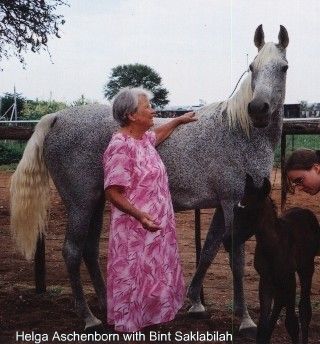
During the years of 2006 and 2007 the Nabilah stud leased the stallion Nafis (Imperial Imdal x Imperial Nefata) from Mr Pieter Burger, who imported him from Dubai. Nafis gave our stud a wonderful infusion of Ansata blood. He is a very tall and athletic stallion with an exceptional neck, shoulder and croup and a beautiful eye. The stud has retained one colt, Nabilah Saqarah (Nafis x Gullilah Saraqa) and a number of fillies. Saqarah inherited the wonderful neck, shoulder and croup from his sire and a beautiful head from his dam.
Athleticism and good movement is an absolute prerequisite for a horse to form part of the Nabilah herd. Our horses have exceptional movement and high tail carriage which in our opinion is becoming scares due to incorrect selection. During 2008 the Nabilah stud came to the conclusion that it needs to import a stallion to take the stud into the future. After a diligent search, we found a colt Marzoukh, at the Kehilan stud in Texas, USA. We are very selective in the bloodlines we use, we do not follow fashion trends but stay true to our goal to breed the noble horse of the desert in all aspects. Due to the fact that we have concentrated on line breeding the Nabilah and Baraka dam line which does not contain Nazeer blood, we have reduced the percentage Nazeer blood in our horses. It is near to impossible to find a straight Egyptian horse with no Nazeer blood. It is our goal to limit the Nazeer blood to create a gene pool that could serve as outcross material for other Egyptian breeders.
I sent an email to the Kehilan stud inquiring about a colt and described what we are looking for in type, conformation and bloodlines. As we are of the opinion that a large dark eye is busy disappearing in Egyptian breeding, this was at the top of our list. I only received a reply a few weeks later as the Kehilan stud was showing horses at the Egyptian Event. I had already forgotten about my enquiry and nearly deleted the mail thinking it was spam. To my surprise I received a reply from Janice from the Kehilan stud stating that they have exactly what I was looking for, a colt bred out of Makhnificent KA and Marquis Jewell a line bred colt to the very beautiful Makhsous. The Makhsous bloodline also does not contain Nazeer which fit in wonderfully with our breeding program. Apart from Makhsous, Marzoukh has a star studded pedigree containing the who’s who in Egyptian breeding.
It was an absolute bonus to hear that Marzoukh was placed second in his class at the Egyptian Event and third in the top five colts. He received very high scores from three top international judges. All three judges scored him above 19 for movement, Marie-Louise van Wyk (a well known South African judge) awarded him 20 for movement. This was exactly what we were searching for. What more can you ask for when choosing a colt, than the opinion of three top international judges.
The decision to take Marzoukh was a mere formality. I planned to visit the Kehilan stud to view Marzoukh but a berth on a plane became available and Marzoukh was on his way to SA. Apart from photos and a video clip we bought Marzoukh unseen. While Marzoukh was in quarantine I visited the Keheilan stud. I was extremely impressed by their horses and their breeding program stretching over two generations. The sire of Marzoukh struck me as the most beautiful stallion I have ever seen. His type is unsurpassed and his conformation perfect. He has large black eyes and a very kind temperament. Read more about the Keheilan stud on their website www.kehilan.com
Marzoukh arrived on our farm after a long journey by road from Cape Town on a stormy and wet evening. The large truck could not negotiate the small road to our farm so we had to walk him the last three kilometres to our farm, in the dark, with a strong wind blowing, lightning cracks and jackals howling. I walked him myself not trusting anybody else to do the job. He had just climbed off a truck in the dark at a strange place and he did not even bat an eyelid, he walked calmly, but very interested in everything, all the way to his new stable.
We thank God for without His blessing this would all not be possible.
Eugene Geyser
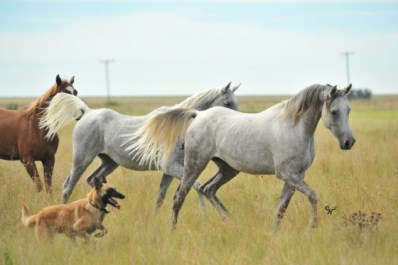
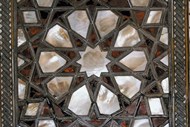
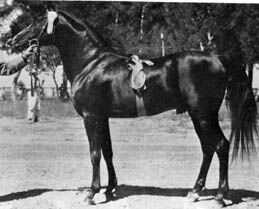
Zahir
Hamasa El Fagr
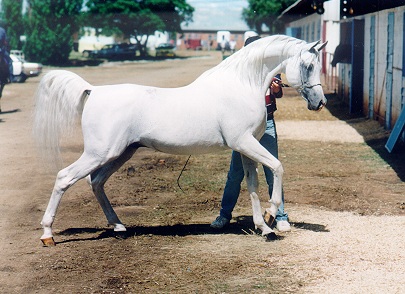
2003 A NEW PARTNERSHIP AND A NEW BEGINNING. By Eugene Geyser
During 2003 a new partnership was formed between Eugene Geyser and Gisela Uijs. The goal of this partnership is to line breed the existing Nabilah offspring in an attempt to preserve the Nabilah bloodlines and most important, the Nabilah type. Eugene had acquired Shari-Silic Pasha. Pasha was a once-off breeding of the very noble Nabilah AK Bint Bashaar (AK El Bashaar x Inzam Saklabilah) to the exquisite Hamasa El Fagr, a world class stallion many times national champion with sought after blood lines, going back in the dam line to Bukra, which proved to be an excellent match. Little did the breeders know that Pasha would play such an important role in the preservation of the Nabilah stud. During the first six years of existence of the partnership we have managed to breed a number of high quality fillies who are line-bred to the dam lines of Nabilah and Baraka all showing the Nabilah type, high tail carriage excellent movement and correct conformation. During 2008, when Pasha reached the age of 16 years, we decided that we could make him available to another stud, as we have bred many beautiful foals out of him. He was sold to Ren and Solet Lubinger, well-known endurance breeders. We hope that they will breed many beautiful foals from Pasha.
LETTER FROM CLAUDE ORPEN
Frikkie Uijs (my late father-in-law) again and again related to me the story of the import and that, due to diplomatic relations, the truth of the further developments about Zad El Rakib had not officially been told, but only in a letter to him privately by Mr. Orpen. It said that a big dispute had arisen about Zad El Rakib, as the Royal Agricultural officials did not want him to leave the country, and tried in vain to undo the transaction. The Syce entrusted with Zad El Rakib had strict orders to try to set him loose, but to make quite sure that it looked like an accident. This then was what happened on the 10-mile walk to the ship. When private Morris managed to catch them, the only option was to poison Zad El Rakib, so that he would not fall into the hands of an “unbeliever”. This is then what happened on the ship. He did not die of colic. I have no written proof of this, as all the letters, documents and photos of the import were lent to Dr Noli Marais. She had wanted to write a book about Baraka and the Import. At her tragic death all the Uijs documents and photos were with her, and I am still trying to locate and return them.
On arrival, no one liked Nader and just to keep the stud pure, Frikkie took Nader along with the two mares Baraka and Nabilah. No two weeks after arriving on Orumbo North, Nader died probably of “nuwe siekte” (strangles) and Baraka and Nabila, though desperately ill pulled through. A second time, the dream of a pure Egyptian Arabian Stud was shattered; the two mares were put to the offspring of the de Villiers horses.
Five years later in 1950 Willhelmus passed away and Baraka was given to Dr Kritzinger (on whose name she had been registered) who promptly sold her to Mr. Kingwill of Graaf Reinett who had also acquired Zahir. He bred the straight Egyptian colt Gordonville Ziyadan (Zahir/Baraka).
As Frikkie Uijs was always concerned about purity of blood, in all his stock, he felt it a shame that a valuable mare like Nabilah should be wasted and therefore sent her all the way from Namibia to the Cape for a covering by the then only pure Egyptian survivor (offspring) of the Orpen import – Gordonville Ziyadan. In 1961 Inzam Saklabila was born. Nabila and Saklabila stayed on Orumbo, producing foal after foal from her half brother out of the de Villiers stock. In later years both mares were sent to an Arab stud in the Free State with the restriction that they were to be bred to Egyptian stock, instead Saklabila was bred to Orange Valley Indian Prince, producing Inzam El Arish, a horse later well known at endurance rides. Four years later she was bred to Vlinkfontein General Dufour although being a good stallion also not of pure Egyptian blood. The colt that was born from this mating, Inzam lbn Dufour, was returned to the farm Orumbo to carry on breeding with the offspring of the de Villiers and Nabilah horses. Old Nabilah died there without producing another foal. In 1974, after the first Fauresmith endurance ride, we went to see this Arab breeder, looking for old Saklabila. We found her, in a shocking condition looking very sad and sorry.
At the beginning of 1974 we were introduced to a man suffering most severely from Arabites, Mr. Helmut Hänsel. He, being an old “South Wester”, we showed the photos we had taken of Saklabila in order to explain how precious the mare was and how worried we were about her. Helmut wasted no time. Within days he had raised Oom Frikkie, who incidentally was in Johannesburg recovering from a neck operation, showed the photos to him, and off they went to pick up old Saklabila in the Free State and take her back to Helmut Hänsel’s smallholding outside Pretoria. Here I would like to underline the fact that, had my mother Helga not so diligently tried to preserve this precious Nabilah blood, had she not written umpteen letters to Oom Frikkie and taken those photos, and had Helmut Hansel not re-acted so promptly, the existence of the pure Egyptian Nabilah blood would have stopped right there.
THE NABILAH STUD
A partnership was formed between dad-in-law and Helmut Hansel and the Inzam Stud were renamed to Nabilah Stud in honor of the foundation mare. Saklabila had no intentions of leaving Helmut Hansel property again and would not load. Helmut then had to convince Mrs. Esslinger who graciously agreed to let her stallion Anchor Hill Omar (Char Echo/Anchor Hill Bint Gamila), a Babson Egyptian import from America, to come to Pretoria to cover Saklabila. It was with much diligence, hard work and financial sacrifice that Helmut Hansel managed to breed two colts and two fillies within 6 years out of old Saklabila then 19 years old. When the colt Nabilah Pascha died of tetanus, Helmut was devastated and did not see his way clear to carry on with the stud. At the beginning of 1981 a new partnership was formed between Frikkie Uijs, Charles Amm and Noel Lancaster. The stud now consisted of three pure Egyptian broodmares: Inzam Saklabila, Nabilah Ziyada, Nabilah Bint Saklabila and the colt Nabilah Scheitan. Charles Amm took Scheitan under his wings, making a prestigious performance horse out of him who won Legion of Merit for performance under saddle, and producing several outstanding foals including the champion mares Gulilah Melek and Naja Aida, before being sold to Dr van Wyk who castrated him and used him as a riding horse for his daughter.
The mares carried on producing foals from Shah Jehan imported from America by Mr. Noel Lancaster and A K El Bashaar the straight Egyptian colt also imported from America, by Charles Amm. At a later stage other stallions like Omar El Shakar and El Fager were also used. In 1988 the partnership was reduced to only Uijs and Lancaster and all the horses were stabled at Noel Lancaster’s Mount Silic Stud. One of the most outstanding horses produced out of the Nabilah line is Shari-Silic Akbar (Omar El Shakar/Nabilah AK Bint Bashaar) many times champion and producer of beautiful foals. Other important progeny are: Nabilah Bint Bashaar (AK El Bashaar/Inzam Saklabila), Shari Silic Pasha (El Fagr/Nabilah Bint Bashaar) and Nabilah Fantasia (Omar El Shaker/Nabilah Bint Saklabila).
On the 15/07/1997 Frikkie Uijs passed away leaving the stud to his two sons, who have entrusted their share of the Nabilah stud to me. After 16 years, the partnership between Uijs and Lancaster was dissolved leaving my share to be one of the original mares that had been brought into the partnership, Nabilah Bint Saklabilah now being almost 19 years old and one filly from her. Nabilah Fantasia. After so many years the Nabilah stud has returned to the farm Orumbo in the now independent Namibia.
It is a very fragile new beginning for the oldest existing Arab stud in Southern Africa, being 63 years old, but we pray that, God willing, it will carry on breeding straight Egyptian Arabs for years to come. Subsequently Helga Aschenborn imported Mahib (Ibrahim x Mahabba). Mahib is bred out of excellent bloodlines. He is a line breeding of the two famous Nazeer sons, Hadban Enzahi and Ghazal. His pedigree also contains Morafic and Alaa El Din. Mahib played a very important role in the Nabilah stud. After approximately five years on Orumbu the Nabilah stud the Nabilah stud grew considerably to allow for a new beginning.
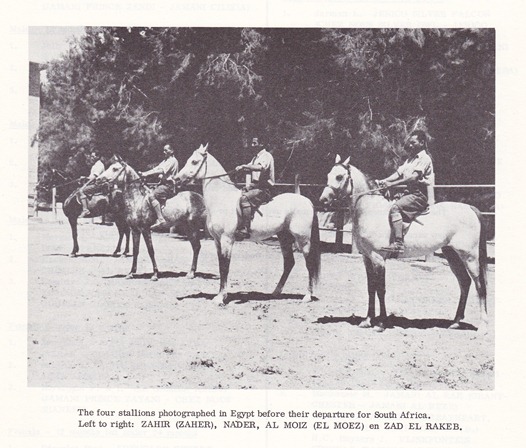

Double click to editGordonville Ziadan
Double click to editInzam Saklabilah
Double clNabilah at Orumbo, Namibia
Anchor Hill Omar
Char Echo (Joe Ferris photo)
Shari Silic Pasha
Bint Saklabilah as a foal, together with her dam, Inzam Saklabilah
Ian Thompson and Tom McNair with Gordonville Ziadan










